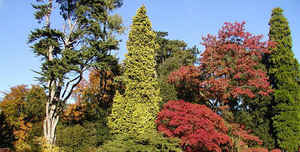
Tennessee Symbols
Tennessee State Tree
Tulip Poplar
(Magnoliaceae Liriodendron tulipifera)
Adopted in 1947.
The tulip poplar, (Magnoliaceae Liriodendron tulipifera,) was designated as the official state tree of Tennessee by Public Chapter 204 of the Acts of the 1947 General Assembly. The act stated that, as no state tree had ever before been designated, the adoption of an official tree seemed appropriate.
The tulip poplar was chosen 'because it grows from one end of the state to the other' and 'was extensively used by the pioneers of the state to construct houses, barns, and other necessary farm buildings.'"("Tennessee Department of State")
See the Bicentennial State Tree: Yellowwood Tree
Tennessee State Tree: Tulip Poplar

The tulip poplar was chosen because it was used extensively by the Tennessee pioneers to construct their houses, barns and other buildings. The tree sometimes reaches a height of 200 feet and frequently shows 50-100 feet of trunk without a branch. The bark is smooth and brownish gray. The leaves are very smooth with a broad notch at the tip. The flowers are tulip-like, green-orange in color, and are 1-3 inches deep. In honor of the state's Bicentennial celebration in 1996, the yellowwood was named Tennessee's bicentennial tree.
The following tulip poplar, the botanical name of which is Liriodendron Tulipifera, is taken from The Complete Guide to North American Trees:
"Perhaps the most stately tree of our range, it sometimes reaches a height of 200 feet with a stem as regular as though turned on a lathe and frequently showing 50 to 100 feet of trunk without a branch. The twigs are smooth, brownish gray, becoming cracked into a regular network of shallow, firm ridges; an old trunk bro-ken into deep, rough ridges. Its leaves are very smooth and shin-ing with a broad notch at the tip, usually four-lobbed, 2 to 8 inches long. Its flowers are tulip-like, green orange, 1 to 3 inches deep. The fruit is cone-like hanging on through the year, and is 2 to 3 inches long."
Identification of the Tulip Poplar

Yellow-poplar (Liriodendron tulipifera), also called tuliptree, tulip-poplar, white-poplar, and whitewood, is one of the most attractive and tallest of eastern hardwoods. It is fast growing and may reach 300 years of age on deep, rich, well-drained soils of forest coves and lower mountain slopes. The wood has high commercial value because of its versatility and as a substitute for increasingly scarce softwoods in furniture and framing construction. Yellow-poplar is also valued as a honey tree, a source of wildlife food, and a shade tree for large areas.
- Leaf: Alternate, simple, palmately veined, orbicular, 4-lobed with an entire margin, 4 to 8 inches long. Somewhat shaped like a tulip.
- Flower: Showy, but high in the tree, 2 1/2 inches long, with yellow-green petals and an orange corolla. Present April to June.
- Fruit: An oblong aggregate of samaras, deciduous at maturity. Each samara is 1-winged, 1 1/2 inches long, and 4-angled. Maturing August to October.
- Twig: Red-brown in color, often with a shiny appearance or a waxy bloom. Stipules are large and encircle the twig. Buds are elongated and valvate, resembling a "duck bill". Twigs have a sweet, spicy odor when broken.
- Bark: Light gray-green in color, often with white in grooves or in patches. Smooth when young, developing flat-topped ridges and furrows in diamond shaped patterns. On older trees sapsucker holes are common.
- Form: In a stand, this tree is very straight with a limb-free bowl. Open-grown trees have a pyramidal crown when young, becoming oval in shape.
Tennessee SENATE BILL NO. 679
PUBLIC ACTS, 1947
CHAPTER NO. 204
SENATE BILL NO. 679
(By White, Cochran)
AN ACT to name a state tree for the State of Tennessee.
WHEREAS, No tree has ever been officially designated as a State Tree for the State of Tennessee; and
WHEREAS, The General Assembly of the State deems it appropriate that such designation be made at this time, and it is generally recognized throughout
the State that the Tulip Poplar grows from one end of the State to the other; and
WHEREAS, The poplar was extensively used by the pioneers of the State to construct houses, barns and other necessary farm buildings in the form of
slabs or hewn logs and later in the form of sawn lumber, popular being more extensively used than any other species of wood; now, therefore,
SECTION 1. Be it enacted by the General Assembly of the State of Tennessee, That the Tulip Poplar is hereby designated and adopted as the Official
State Tree of the State of Tennessee.
SEC. 2. Be it further enacted, That this Act shall take effect from and after its passage, the public welfare requiring it.
Tennessee Law
The law designating the tulip poplar as the official Tennessee state tree is found in the Tennessee Code Annotated, Title 4, Chapter 15, Part 3, Section 4-1-305.
Title 4 State Government
Chapter 1 General Provisions
Part 3 State Symbols
Tenn. Code Ann. § 4-1-305 (2011)
4-1-305. State tree.
The tulip poplar is designated and adopted as the official state tree of this state.
HISTORY: Acts 1947, ch. 204, § 1; C. Supp. 1950, § 107.3; T.C.A. (orig. ed.), § 4-108.
Taxonomic Hierarchy: Tulip tree
Kingdom: Plantae - Plants
Subkingdom: Tracheobionta - Vascular plants
Superdivision: Spermatophyta - Seed plants
Division: Magnoliophyta - Flowering plants
Class: Magnoliopsida - Dicotyledons
Subclass: Magnoliidae
Order; Magnoliales
Family: Magnoliaceae - Magnolia family
Genus: Liriodendron L. - tuliptree
Species: Liriodendron tulipifera L. - tuliptree







